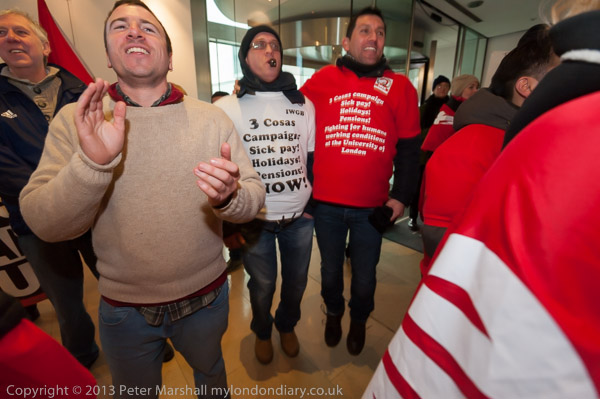 .IWGB protesters inside the Royal Opera House foyer
.IWGB protesters inside the Royal Opera House foyer
I’m not in favour of contests and awards. Certainly I won’t go to photograph the stars arriving at things such as the BAFTA awards at the Royal Opera House (ROH), though I did pop in there briefly last month, along with workers from the IWGB (Independent Workers Union of Great Britain.) The bus taking them around on the second day of their strike at the University of London paid a visit there after the lunchtime rally outside Parliament stopped around the corner, and we were all told to get off quietly and made our way into the foyer of the ROH.
There was a little pushing I think to get inside, though I simply waited briefly until they were occupied grabbing one or two and walked in with the rest of the protesters. Inside were a few police watching, as well as ROH staff, and members of the public at the box office.
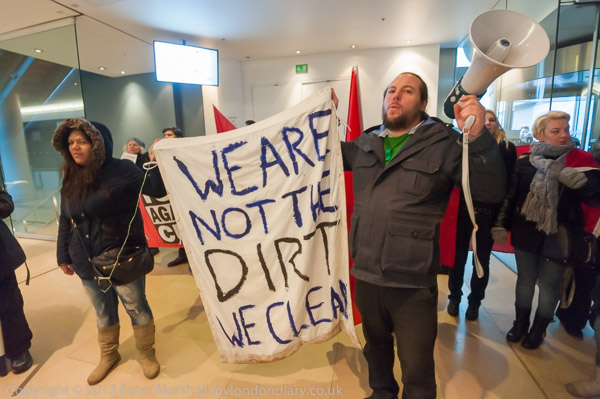
The IWGB strikers were there in support of their union colleagues who clean the ROH, and who are demanding a living wage and union recognition. Although the vast majority of cleaners and porters there are IWGB members , the ROH management and Mitie, the contracting firm that employs them, has recognised another union, Unison, and refuses to talk to the IWGB.
The IWGB was threatening to strike on the day of the BAFTA awards – Feb 16th. It was a strike that they ROH would have found intensely embarrassing and would have gained huge media coverage, with support from both Equity and the Musicians Union, and, unlike Labour Party shadow education secretary Tristram Hunt, trade unionists would not have crossed the IWGB picket lines.
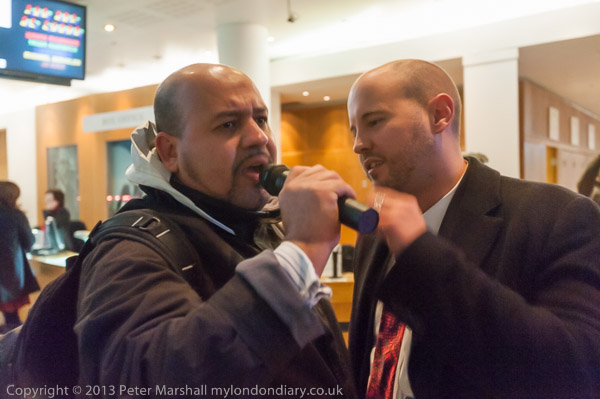
The first response of the ROH and Mitie was to recognise another union that has few if any members among the cleaners and porters and to negotiate with them, conceding the demand for a living wage. The first the IWGB knew about this was when they began their protest inside the ROH, when a man who later introduced himself as the Unison Health and Safety Rep tried unsuccessfully to take the microphone away from IWGB President Alberto Durango, telling him that Unison had reached an agreement with the management.
Some time later Mitie did confirm in writing that they had agreed the proposals on the IWGB and the strike – which had received 100% support in a ballot of members – was called off.
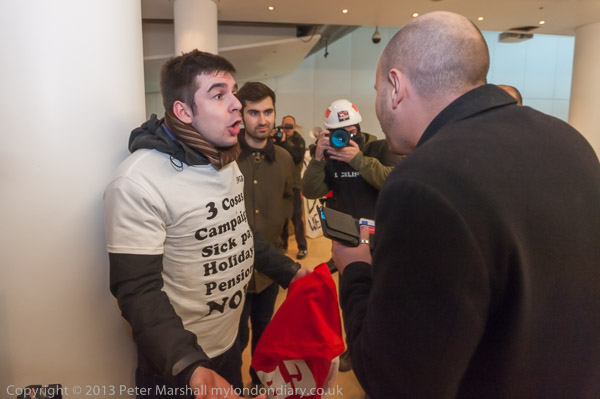
Of course there is still a dispute over union recognition, though it seems to be crazy for management not to recognise the union that the workers actually belong to. It does seem to be an area of employment law (governed by the Employment Act 1999) which appears sadly deficient in some respects. Mitie doesn’t like the IWGB because it is good at organising members and representing their interests, and appears to be happier at dealing with a larger union which cannot involve the workers.
I’d set the ISO on my cameras to ISO 3200 as we entered the foyer, and the lighting inside was a little dim, but just workable. At full f4 aperture on the 16-35mm shutter speeds varied from 1/20 to 1/100 th in various areas. For static subjects I would have been quite happy, but with these shutter speeds subject movement presented something of a problem. I prefer not to use flash if I can avoid it, both because it creates its own problems of uneven lighting and because I’ve found I more often get asked to stop taking pictures if I’m using flash, probably because it is just more obvious.
But once I was sure I had some pictures, I switched on the flash, still keeping the ISO at 3200 but bouncing in a little extra light onto the closer subjects from the low (and fairly white) ceiling and switching from program mode to shutter priority at 1/60th or 1/100th. Later when I moved in close to photograph an argument, I switched the flash off to be less intrusive. Bounce flash from the ceiling doesn’t work in any case when you are very close to your subject.
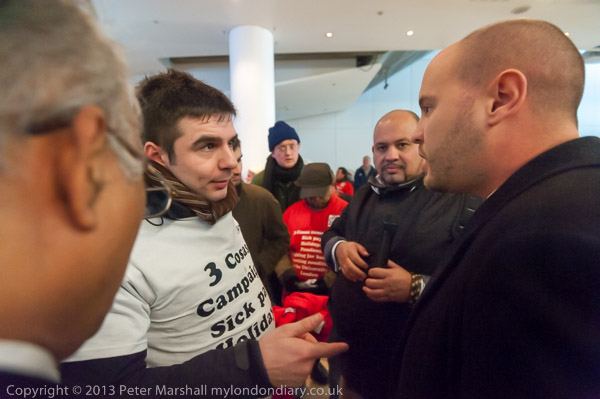
While I was photographing, one man, I think one of the ROH management talked to me, asking me why two of the other people taking photographs had masked their faces. “Are they ashamed of what they are doing?” he asked, “Why do they feel a need to hide their faces?”
It wasn’t a question I could answer. As I told him, I wasn’t ashamed, but proud and the only thing that hides my face is a beard. Personally I think masking by photographers is largely if not entirely an over- dramatic affectation.
______________________________________________________
My London Diary : Buildings of London : River Lea/Lee Valley : London’s Industrial Heritage
All photographs on this and my other sites, unless otherwise stated, are taken by and copyright of Peter Marshall, and are available for reproduction or can be bought as prints.
To order prints or reproduce images
________________________________________________________